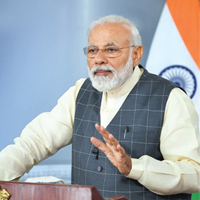The Modi factor: India 2024 and Beyond
By Raj Shah
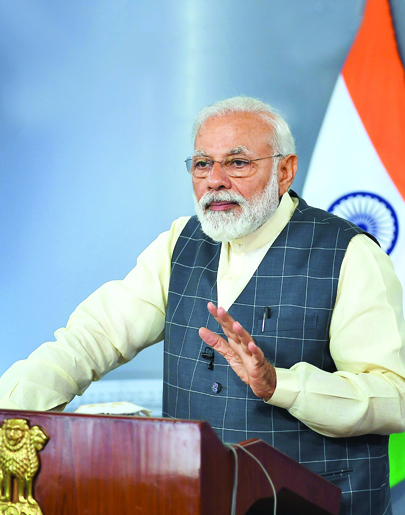
In the sprawling tapestry of global politics and economic dynamics, India stands out not only as a burgeoning superpower but also as a pivotal player shaping the 21st-century geopolitical landscape. Central to India’s ascendancy on the world stage is Narendra Modi, whose leadership since 2014 has been both polarizing and transformative. As India looks towards 2024 and beyond, understanding the “Modi factor” involves dissecting his policies, the economic trajectory under his governance, and the broader implications of his leadership for India and its global interactions.
Economic Reforms and Growth
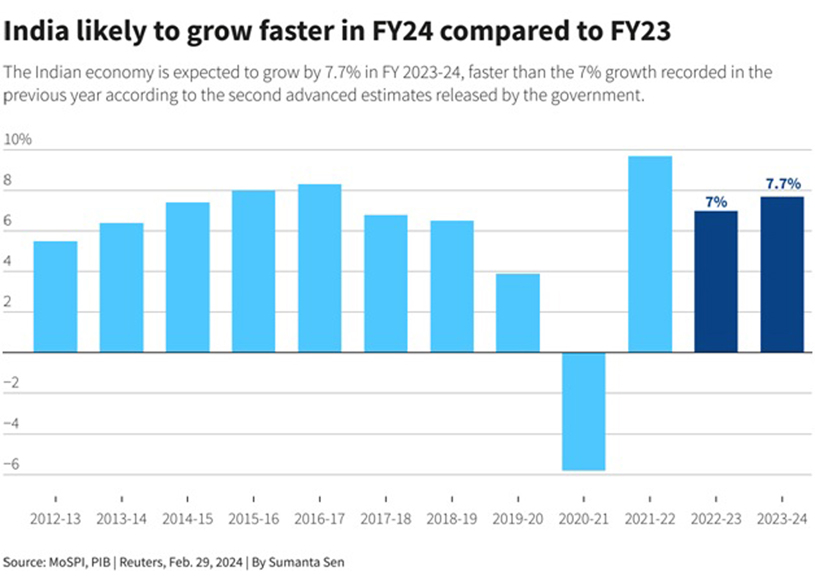 Since taking office, Modi has introduced significant economic reforms aimed at boosting growth, improving governance, and enhancing transparency. Perhaps the most notable among these was the implementation of the Goods and Services Tax (GST) in 2017, which replaced a myriad of state and federal taxes with a single, unified tax system, intended to create a seamless national market and increase tax compliance. This move, according to the World Bank, has the potential to boost India’s GDP by about 1.5 percentage points over the long run.
Since taking office, Modi has introduced significant economic reforms aimed at boosting growth, improving governance, and enhancing transparency. Perhaps the most notable among these was the implementation of the Goods and Services Tax (GST) in 2017, which replaced a myriad of state and federal taxes with a single, unified tax system, intended to create a seamless national market and increase tax compliance. This move, according to the World Bank, has the potential to boost India’s GDP by about 1.5 percentage points over the long run.
The controversial demonetization of Rs. 500 and Rs. 1,000 currency notes in November 2016, aimed at curbing black money and digitalizing the economy, was another pivotal reform. While this led to a temporary slowdown in economic activity and significant public inconvenience, it also resulted in increased digital financial transactions, promoting transparency, and widening the tax base.
Under Modi’s tenure, India’s GDP growth has seen highs and lows, peaking at 8.3% in 2016 before dipping to an 11-year low in 2020 due to the COVID-19 pandemic. However, the government’s aggressive vaccination campaign and subsequent economic stimulus packages helped stabilize the economy. The International Monetary Fund (IMF) forecasts India’s growth to be robust, projecting it as one of the fastest-growing major economies in the coming years.
5th largest economy by 2030 and 3rd largest economy by 2047
PM Modi outlines an ambitious vision for India’s economic trajectory, aiming to position it as the fifth largest economy by 2030 and the third largest by 2047. These goals reflect Prime Minister Narendra Modi’s broader strategy to harness India’s demographic dividend, enhance technological integration, and boost infrastructure development.
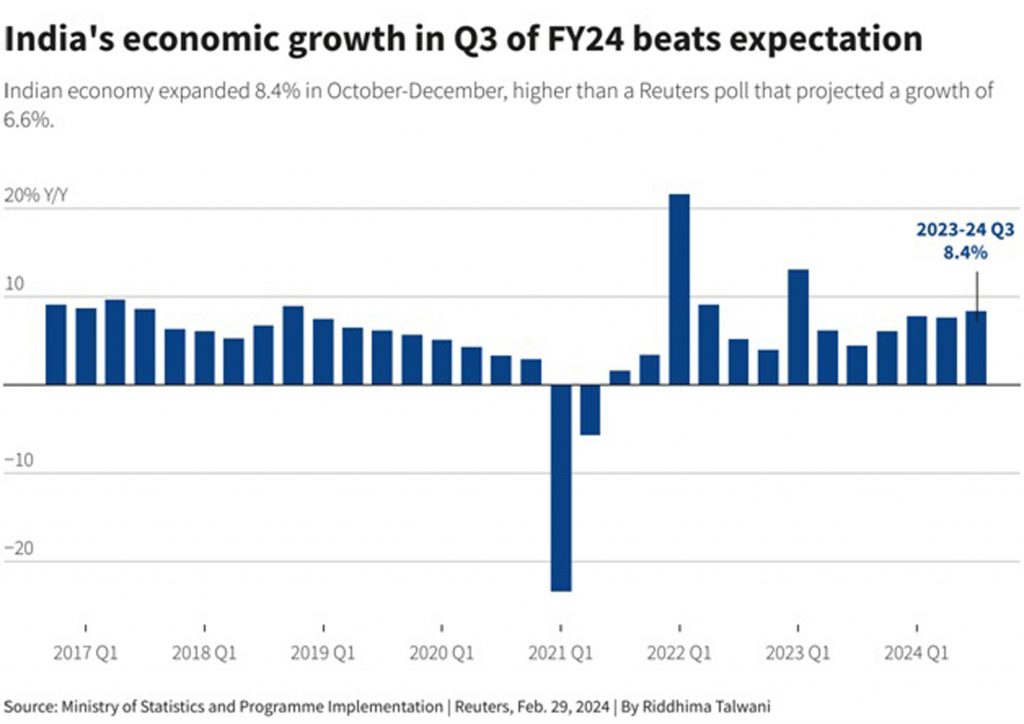 Firstly, achieving the status of the fifth largest economy by 2030 requires India to maintain robust GDP growth, improve its manufacturing sector, and enhance its digital infrastructure. The government’s “Make in India” initiative is pivotal here, aiming to turn the nation into a global manufacturing hub. Initiatives such as “Digital India” aim to transform the country into a digitally empowered society and knowledge economy, utilizing information technology to foster growth.
Firstly, achieving the status of the fifth largest economy by 2030 requires India to maintain robust GDP growth, improve its manufacturing sector, and enhance its digital infrastructure. The government’s “Make in India” initiative is pivotal here, aiming to turn the nation into a global manufacturing hub. Initiatives such as “Digital India” aim to transform the country into a digitally empowered society and knowledge economy, utilizing information technology to foster growth.
Secondly, the vision for 2047 coincides with India’s centenary of independence and aims even higher: to make India the world’s third-largest economy. This long-term goal involves strategic reforms in education, higher foreign direct investment, and a stronger push towards renewable energy, aligning with global shifts towards sustainability. Modi’s government is also emphasizing the need to improve governance through transparency and the rule of law, which are crucial for sustaining economic growth and investor confidence.
Modi’s vision is not just about economic numbers but a broader vision for an inclusive, technologically advanced, and globally integrated India. Achieving these targets will require a multifaceted approach involving substantial reforms, societal participation, and continuous innovation, making the journey towards these milestones as significant as the goals themselves.
Modi’s approval rating
Prime Minister Narendra Modi is currently the world’s most popular leader, boasting a formidable 76% approval rating, according to the latest Morning Consult report. This high rating reflects widespread support within India as well as a strong endorsement of his leadership style and policies on a global scale. The survey included adult residents from various countries, highlighting international opinions on global leadership, with Modi ranking higher than other leaders such as Mexico’s President López Obrador and Swiss President Alain Berset, who hold ratings of 66% and 58%, respectively.
Modi’s leadership, noted for its nationalistic and development-focused approach, resonates strongly with his domestic base amidst global economic challenges and geopolitical tensions. This popularity is significant in India’s upcoming general elections because it positions Modi and his party, the Bharatiya Janata Party (BJP), strategically within the electoral landscape. His sustained approval also bolsters India’s diplomatic stance in international affairs, underscoring the potential future directions of India’s domestic and foreign policies under his continued leadership.
Global Leadership and Diplomacy
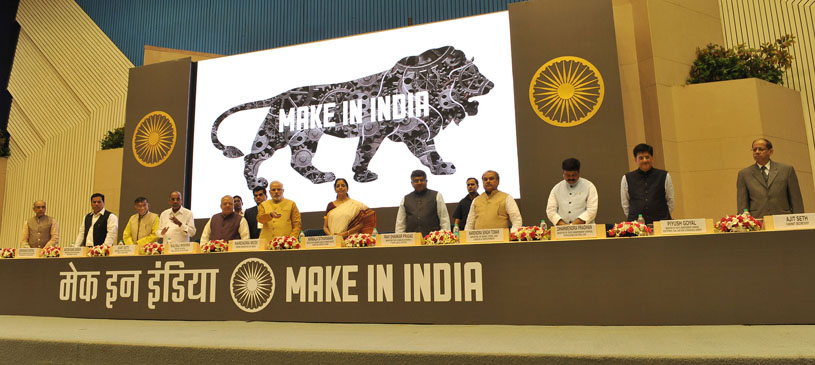
Narendra Modi, India’s Prime Minister since 2014, has significantly shaped global diplomacy under his leadership. His “Modi Doctrine” advocates proactive, strategic international engagement to boost India’s global standing. Modi focuses on strengthening both bilateral and multilateral relationships, enhancing ties with major powers like the US, Russia, and the EU, and deepening connections within South Asia. His ability to forge personal connections with other world leaders has helped diversify India’s strategic partnerships, notably with Japan and Australia.
Modi is active in international forums like the United Nations, G20, and BRICS, pushing for global governance reforms and advocating on critical issues such as terrorism, climate change, and sustainable development. By aligning these issues with global priorities, Modi positions India as a responsible international actor. His use of soft power to promote India’s cultural and developmental achievements further boosts its diplomatic and economic influence, reflecting his vision of a globally assertive India.
India’s stance on the Russia-Ukraine conflict
India, under Prime Minister Narendra Modi, has maintained a nuanced approach to the Russia-Ukraine conflict, exemplifying its broader foreign policy tenets and long-standing ties with Russia. India has advocated for dialogue and diplomacy to resolve the conflict, carefully avoiding direct criticism of Russia’s actions.
Key aspects of India’s stance include:
- Strategic Autonomy: India’s strategic autonomy policy aims to balance its international relationships without aligning closely with any major power bloc. This principle is evident in its handling of the Russia-Ukraine situation and extends to its overall global interactions.
- Historical Relations with Russia: The India-Russia partnership, rooted in the Cold War, continues to influence India’s diplomatic choices. Russia remains India’s major defense supplier, affecting its response to the conflict.
- Energy and Economic Considerations: Russia is crucial for India’s energy needs, especially with fluctuating global energy prices. Following Western sanctions on Russia, India has notably increased its import of Russian oil, benefiting economically.
- Balancing Western Relationships: Despite its cautious stance on Russia, Modi’s administration has strengthened ties with Western nations, balancing its foreign relations while engaging in strategic forums like the Quad, which involve the U.S., Australia, and Japan.
- Global Platforms and Non-Alignment: At international forums such as the United Nations, India promotes sovereignty and territorial integrity but has abstained from condemning Russia, showcasing its commitment to non-alignment and a multipolar world order.
Modi’s foreign policy also emphasizes strengthening regional relationships and assertiveness on global platforms. His leadership was prominent at the G20 summit, focusing on issues like sustainable development and climate change. Additionally, Modi advocates for the reform of global institutions, reflecting the current dynamics of international relations amid managing complex relationships with key countries like China, especially after border tensions.
Influence on Other Countries
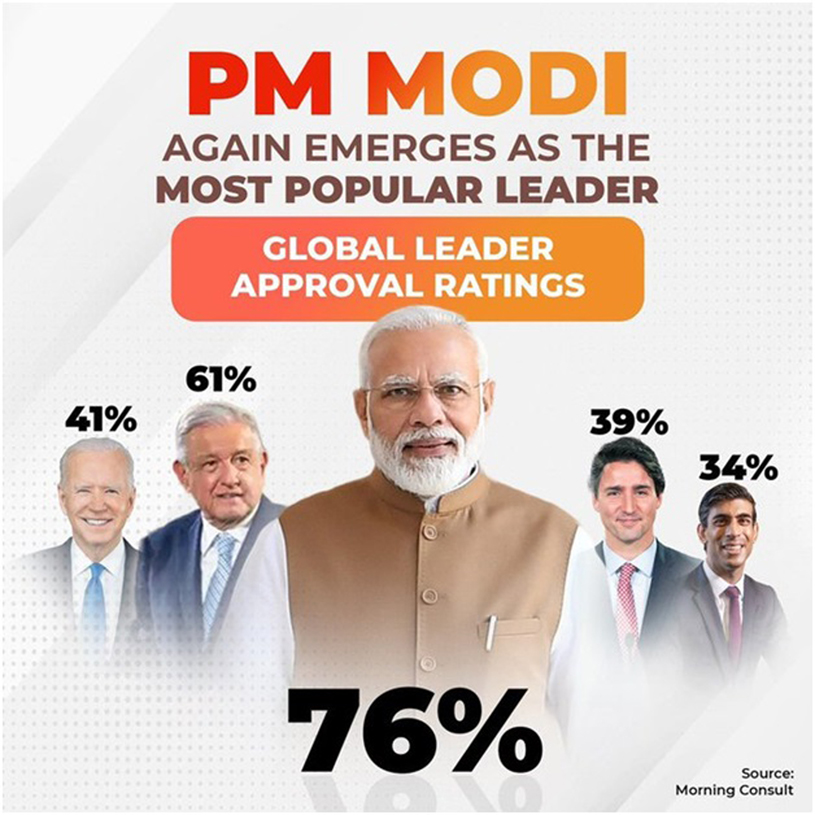
India’s influence under Modi extends beyond economics and politics. The country has positioned itself as a leader in renewable energy, committing to ambitious targets under the Paris Agreement. Modi’s championing of the International Solar Alliance highlights India’s commitment to fostering global cooperation against climate change.
Moreover, Modi’s diplomatic efforts have enhanced India’s soft power. Initiatives such as Yoga Day have gained international recognition, promoting Indian culture on a global scale. Similarly, India played a pivotal role during the pandemic by supplying vaccines to several countries under the “Vaccine Maitri” initiative, enhancing its image as a responsible global leader by leveraging its pharmaceutical capabilities.
India’s Thriving Digital Economy: A New Frontier
India’s digital economy is a burgeoning force, catalyzing innovation and growth across multiple sectors. As the world increasingly embraces digital technologies, India is not just participating; it is leading the way in many aspects. Widespread internet adoption, governmental policies encouraging digitalization, and a dynamic entrepreneurial ecosystem drive the transformation.
Digital infrastructure and connectivity
India’s robust digital infrastructure is at the heart of the country’s digital economy. Launched in 2015, the government’s ambitious “Digital India ” initiative aimed to ensure broadband connectivity in all panchayats, enable digital literacy, and make government services electronically available. There were 821 million internet users in India at the start of 2024, when internet penetration stood at more than 55.0 percent, a testament to the rapid digitalization that has penetrated the nation’s vast rural and urban landscapes. India was home to 462.0 million social media users in January 2024, equating to 32.2 percent of the total population. In early 2024, India had a total of 1.12 billion cellular mobile connections, which equates to 78.0 percent of the total population.
Significant improvements in connectivity infrastructure support this digital push. The introduction of 4G and the ongoing rollout of 5G are pivotal, drastically improving internet speed and reliability, which, in turn, enhances consumer experience and connectivity.
E-Commerce and Digital Finance
A surge in the online consumer base and an increase in digital literacy have driven exponential growth in the e-commerce sector in India. Companies like Flipkart, Amazon, and a plethora of homegrown startups have transformed the retail landscape, offering everything from groceries to high-end electronics at the click of a button. The COVID-19 pandemic further accelerated this trend, pushing more consumers to embrace online shopping as a safe and convenient option.
Parallelly, digital finance has revolutionized the way Indians transact. The Unified Payments Interface (UPI) system, which simplifies inter-bank transactions saw 117.6 billion transactions in 2023, with a total value of $ 2.18 trillions. This is a 59% increase in volume and a 45% increase in value compared to 2022. In December 2023, UPI processed 12.02 billion transactions, which is a 54% increase in volume and a 42% increase in value year-on-year
Mobile wallets and fintech services have democratized access to financial services, providing platforms for investments, savings, and even loans previously inaccessible to large segments of the population.
Startup ecosystem and innovation
India’s digital economy is also characterized by a vibrant startup ecosystem, thriving particularly in sectors like fintech, edtech, and healthtech. Indian startups such as Paytm, BYJU’s, and Ola have not only disrupted traditional industries but have also attracted substantial foreign investment. The government’s supportive policies, including tax benefits for startups and funds for innovation, have further bolstered this landscape.
Furthermore, India is a hub for software development and IT services, with one of the world’s largest talent pools. This sector not only serves domestic needs but also exports IT expertise globally, making it a critical component of the digital economy.
Election 2024
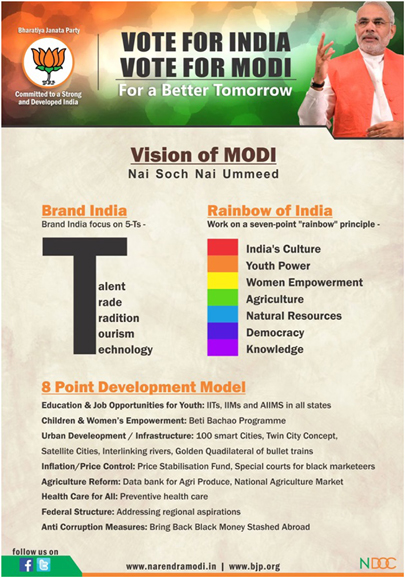 India’s 2024 general elections are crucial, with Prime Minister Narendra Modi seeking a third term. Modi, the leader of the Bharatiya Janata Party (BJP), is a prominent and polarizing figure in Indian politics, celebrated for his charismatic leadership and contentious policies. Since his election in 2014, his government has introduced major initiatives like the Goods and Services Tax (GST) and demonetization of large currency notes, emphasizing digital infrastructure and national security.
India’s 2024 general elections are crucial, with Prime Minister Narendra Modi seeking a third term. Modi, the leader of the Bharatiya Janata Party (BJP), is a prominent and polarizing figure in Indian politics, celebrated for his charismatic leadership and contentious policies. Since his election in 2014, his government has introduced major initiatives like the Goods and Services Tax (GST) and demonetization of large currency notes, emphasizing digital infrastructure and national security.
While Modi’s efforts to modernize the economy and his assertive foreign policy have earned admiration, his tenure has also faced criticism for allegedly exacerbating religious divides and suppressing dissent. The BJP has maintained wide support by combining Modi’s appeal with effective party organization and nationalistic, development-focused campaign strategies.
The opposition parties have united against PM Modi’s re-election efforts. Their success hinges on presenting a cohesive and compelling alternative to Modi’s vision. Unfortunately, they have not been able to pick a strong candidate against PM Modi, or they have not been able to define their vision. As the elections are underway, voter focus will likely center on economic outcomes, social policies, and public health issues, especially post-COVID-19. The results will significantly influence India’s domestic and international direction.
Modi hai to mumkin hai
The slogan “Modi hai to mumkin hai” (If Modi is there, it is possible), coined by the Bharatiya Janata Party (BJP), underscores Prime Minister Narendra Modi’s transformative leadership and pivotal role in India’s policies and developments. Introduced during the 2019 Indian general elections, it emphasized Modi’s first-term achievements, such as the implementation of the Goods and Services Tax (GST), the promotion of digital transactions with Digital India, and advances in international diplomacy. The slogan aimed to appeal broadly to the electorate by depicting Modi as a visionary capable of surpassing formidable challenges.
Psychologically, the slogan resonates with the Indian public’s desire for decisive leadership amidst common political disillusionment, projecting confidence and competence. Politically, it serves as a strategic tool for mobilization and personal branding, positioning Modi as synonymous with progress and making his leadership a focal point in election campaigns.
The phrase’s effectiveness also reflects the BJP’s adept use of sophisticated media strategies, utilizing traditional, digital, and social media to ensure widespread dissemination. Featured in various media forms, like TV spots and social media memes, the slogan significantly impacts the public psyche.
Culturally, “Modi hai to mumkin hai” marks a shift towards American-style political campaigning in India, focusing on personal branding and direct voter communication. As a potent example of modern political communication, the slogan illustrates how digital-age slogans not only drive political campaigns but also shape and reflect societal values and expectations. Its influence on India’s political and social landscapes highlights its dual role as an emblem of strong leadership and the centralization of power.
Modi Ki Guarantee
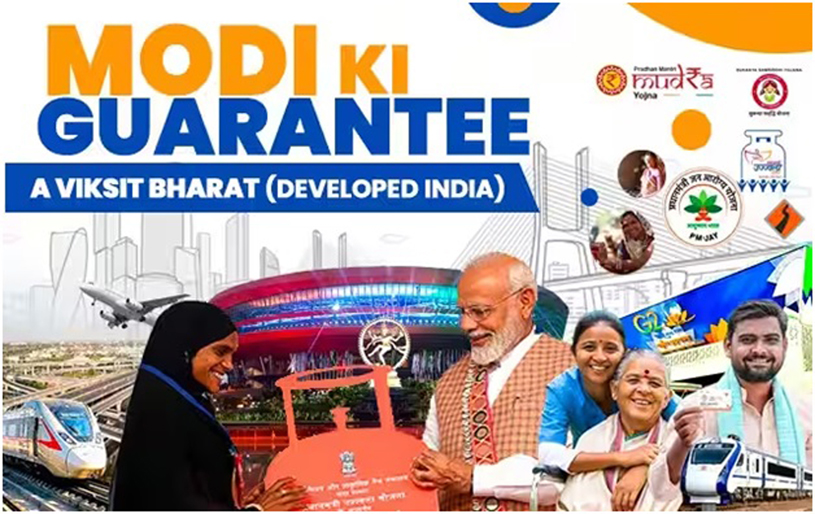 “Modi Ki Guarantee,” or “Modi’s Guarantee” in English, is a political slogan closely associated with Indian Prime Minister Narendra Modi. It embodies his personal commitment to fulfilling policy promises, suggesting that Modi himself stands directly behind these commitments. This personal assurance is a strategic element in political communication, simplifying complex policies into tangible guarantees from Modi, which boosts public confidence and trust in his leadership.
“Modi Ki Guarantee,” or “Modi’s Guarantee” in English, is a political slogan closely associated with Indian Prime Minister Narendra Modi. It embodies his personal commitment to fulfilling policy promises, suggesting that Modi himself stands directly behind these commitments. This personal assurance is a strategic element in political communication, simplifying complex policies into tangible guarantees from Modi, which boosts public confidence and trust in his leadership.
The slogan has significant electoral impacts: it enhances trust and loyalty by presenting Modi as a dependable figure accountable for his promises, raises public expectations by personalizing governmental commitments, and serves as a unique branding tool that positions Modi above his competitors, reinforcing his image as a confident leader willing to stake his reputation on his policies. “Modi Ki Guarantee” thus effectively enhances Modi’s political image and fosters greater accountability in his leadership approach.
Aab ki baar, 400 paar
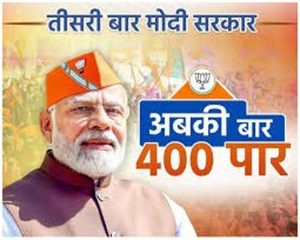 Prime Minister Narendra Modi’s slogan “Aab ki baar, 400 paar” for the 2024 general elections epitomizes the Bharatiya Janata Party’s (BJP) goal to secure over 400 of the 543 Lok Sabha seats. More than just a numerical ambition, this slogan serves as a political statement that aims to energize the BJP’s base, secure a decisive mandate, and portray stable, strong governance under Modi’s leadership.
Prime Minister Narendra Modi’s slogan “Aab ki baar, 400 paar” for the 2024 general elections epitomizes the Bharatiya Janata Party’s (BJP) goal to secure over 400 of the 543 Lok Sabha seats. More than just a numerical ambition, this slogan serves as a political statement that aims to energize the BJP’s base, secure a decisive mandate, and portray stable, strong governance under Modi’s leadership.
The BJP, leveraging Modi’s appeal, focuses on digital and economic reforms, as well as national security, which resonates with a diverse voter base. The phrase sets a narrative of dominance, suggesting the BJP’s inevitable victory, challenging itself to win convincingly and demoralizing the opposition. As elections near, this slogan will dominate the BJP’s campaign, underscoring Modi’s pivotal role and setting up a high-stakes battle for a potentially historic majority.
PM Modi’s Vision: 2024 and Beyond
India, on the way of significant transformation, envisions a future characterized by substantial economic growth and global leadership. As we look beyond 2024, Prime Minister Narendra Modi’s vision for India encapsulates a strategic roadmap to becoming the 5th largest economy by 2030 and ascending to the 3rd position by 2047, the centennial year of its independence.
This ambitious trajectory is not just about economic growth in numbers but also reflects a broader aim of establishing India as a ‘Vishva Guru’—a guiding force for global wisdom and leadership. India’s rich historical context of contributing knowledge and values to the world deeply roots this concept. India’s economic aspirations and cultural influence deeply intertwine with its vision as a “Vishva Guru” or world leader. The term “Vishva Guru” implies not only economic leadership but also a guiding force in spirituality, philosophy, and governance, reflecting India’s historical role as a cradle of significant intellectual and spiritual movements.
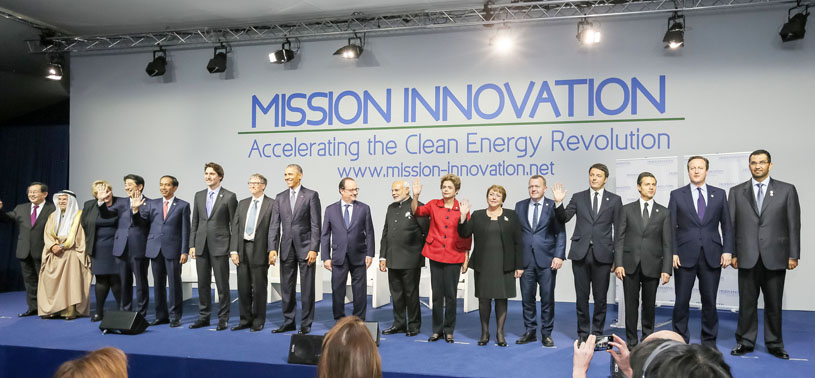
Firstly, economic reforms are crucial. The government has been emphasizing manufacturing through initiatives such as ‘Make in India’, which aims to turn the country into a global manufacturing hub. Efforts to enhance business ease, draw in foreign investments, and stimulate major sectors like agriculture, textiles, and technology complement these efforts.
Technology is another pillar of Modi’s vision. India is poised to transform its innovation landscape with the advent of the digital revolution. The push for digitization in public services and the emphasis on science and technology education aim to prepare a future-ready workforce that can lead tech-driven transformations not only within but also internationally.
Moreover, there are plans to strengthen India’s role on the international stage. Through policies that promote sustainable development and global peace, India aims to showcase its commitment to addressing world issues like climate change and international security.
The ethos of inclusive growth and sustainable development underpins India’s journey to become a global economic powerhouse and a ‘Vishva Guru’. By 2047, India aims to be not just a statistic on the list of world economies but a leader in fostering global harmony and prosperity.
As India approaches critical national elections in 2024, the “Modi factor” remains a potent force. His appeal as a leader who embodies assertiveness and developmental promise plays well with a significant portion of the Indian electorate. We expect Modi’s leadership style, marked by decisive action and visionary planning, to guide India through these challenges, not only to overcome them but to use them as opportunities to solidify India’s position as a formidable global presence.
About the Author:
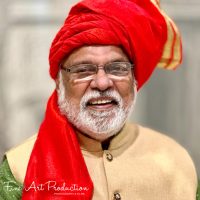 A software engineer by profession, Indian culture enthusiast, ardent promoter of hinduism, and a cancer survivor, Raj Shah is a managing editor of Desh-Videsh Magazine and co-founder of Desh Videsh Media Group. Promoting the rich culture and heritage of India and Hinduism has been his motto ever since he arrived in the US in 1969.
A software engineer by profession, Indian culture enthusiast, ardent promoter of hinduism, and a cancer survivor, Raj Shah is a managing editor of Desh-Videsh Magazine and co-founder of Desh Videsh Media Group. Promoting the rich culture and heritage of India and Hinduism has been his motto ever since he arrived in the US in 1969.
He has been instrumental in starting and promoting several community organizations such as the Indian Religious and Cultural Center and International Hindu University. Raj has written two books on Hinduism titled Chronology of Hinduism and Understanding Hinduism. He has also written several children books focusing on Hindu culture and religion.

